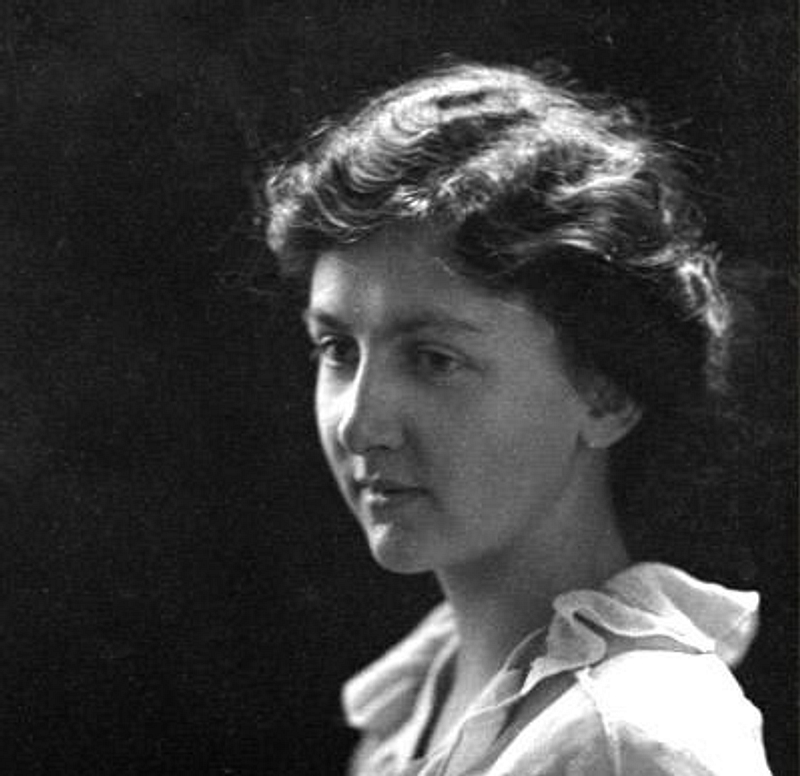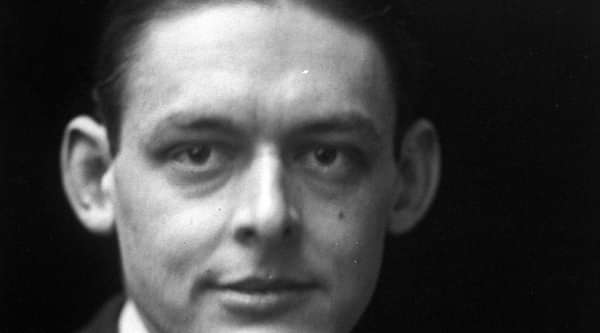
October 23, 2018
A secret life in letters
The mystery surrounding the ambiguous relationship between T.S. Eliot and an Abbot teacherby Katie Fiermonti
The mystery surrounding the ambiguous relationship between the world-famous writer and the Abbot Academy drama teacher will be brought to light when Princeton University Library makes public more than 1,000 never-before-revealed letters T.S. Eliot wrote to Emily Hale during the mid-1900s.
Jane Christie ’58 remembers the photograph of famed poet T.S. Eliot in her drama teacher’s apartment. It sat on a bureau in Emily Hale’s Northampton residence, where Hale was living following her teaching career at Abbot Academy.
Christie, who was continuing her studies at Smith College after graduating from Abbot, occasionally visited Hale at her home for tea.
“The photograph was large. And though I remember it was inscribed, I am foggy on the inscription,” says Christie. “Clearly, he’d given it to her.”
The mystery surrounding the ambiguous relationship between the world-famous writer and the drama teacher from Boston will soon be brought to light. On January 2, 2020, Princeton University Library’s Department of Rare Books and Special Collections plans to make public more than 1,000 letters Eliot wrote to Hale during the mid-1900s. Never before revealed, the letters were donated by Hale with the stipulation that they be unsealed 50 years after the latter of their deaths; she died after Eliot in 1969. The correspondence could illuminate what scholars have long debated: What was the true nature of Eliot and Hale’s secret relationship?
 Emily Hale, 1914
Emily Hale, 1914
“I became fascinated with the notion that [Eliot] had this American girlfriend no one knew about,” says Sara Fitzgerald, an author, journalist, and consultant who is writing a novel about Hale’s life. During Reunion Weekend in June, Fitzgerald described her research and findings to a room packed with Abbot alumnae—including some who had Hale as a teacher. It was the same room—the School Room in Abbot Hall—where Eliot, at the invitation of Hale, addressed students in the spring of 1956.
“Emily Hale is painted as someone who fell apart, who had a nervous breakdown after loving Eliot for so many years and seeing him marry another woman,” adds Fitzgerald. “I didn’t necessarily find that to be the case. I felt she got over this blow and kept living.”
Abbot alumnae who remember Hale directing them in plays or correcting their diction describe her as a small woman with a modest, kind demeanor.
“She was very old-school,” laughs Sandra Castle Hull ’58, who acted in one of the plays Hale directed, She Stoops to Conquer. “If she said for you to have your lines learned by Wednesday, you learned your lines by Wednesday!”
An Abbot drama teacher from 1947 to 1957, Hale grew up in a well-connected Boston Brahmin household. She attended the Berkeley Street School in Cambridge and Miss Porter’s School in Farmington, Conn., but did not attend college. According to Fitzgerald, “Emily longed to be a professional actress, but her family did not consider that to be an appropriate career for a woman.”
Eliot and Hale met in 1913 and became very close. He was 24 and a student at Harvard. She was 21.
”“They may have met at a debutante party,” says Fitzgerald. “I decided to begin my novel in February 1913, when he and Emily performed in a stunt show to benefit a local charity. Emily sang several popular songs, and she and Tom appeared together in a skit based on a scene from Jane Austen’s novel Emma. They also participated in an amateur theater group called the Cambridge Social Dramatic Club.”
Eliot left Boston for Oxford University in 1914, and according to published writings left by Eliot’s second wife, Valerie Eliot, the poet said he had told Hale he was in love with her, though he later maintained that she didn’t reciprocate at the time. In November of that year, Eliot wrote to his friend Conrad Aiken, asking him to arrange to deliver Hale roses at a play in which she was performing. But in 1915, Eliot suddenly married Vivienne Haigh-Wood, an English governess and artist, just three months after their first meeting in Cambridge, England. The marriage was highly publicized as an unhappy one, with the couple separating and Haigh-Wood spending years in a mental asylum, where she died in 1947. Eliot, who became an English citizen in 1927, took a vow of celibacy the following year.
“So, what happened to Emily?” asks Fitzgerald. “She went to visit her aunt and uncle in Seattle and took acting classes there. She returned to Boston and assumed starring roles in major amateur productions. Based on the available newspaper reviews, she was obviously talented.” Hale taught voice instruction at Simmons College, then went on to teach at Milwaukee-Downer College in Wisconsin, and traveled several times to Europe.
In 1927, at the age of 36, she decided to write to Eliot, rekindling a relationship that would result in both parties crossing the Atlantic to visit each other, even when Hale took a teaching job at Scripps College in California. Fitzgerald says the still-married Eliot gave Hale a ring and attempted to obtain a legal separation from his wife. When Hale was teaching at Smith College, Eliot sent her drafts of his play The Family Reunion for her suggestions, some of which he incorporated. “The play focuses on the guilt a husband feels following the death of his wife; biographers believe Miss Hale was the model for one of the characters,” says Fitzgerald.
Hale remained in Eliot’s thoughts and is also believed by some literary critics to be wistfully immortalized in many of his poems, including “Burnt Norton,” Eliot’s 1935 poem that refers to an abandoned Oxford estate garden the pair explored together during one of Hale’s visits.
…Footfalls echo in the memory
Down the passage which we did not take
Towards the door we never opened…
But time, distance, careers, and the outbreak of World War II kept them apart, and the relationship eventually faltered.
The degree of romance between Hale and Eliot has never been definitively determined, though Fitzgerald believes the Nobel Prize–winning poet strung Hale along for years. Post-war, the relationship would never recover.
Hale came to Abbot Academy as a drama teacher and instructor of elocution in 1947, about a year after Haigh-Wood’s death. She may have still hoped that Eliot would eventually marry her, but a proposal never came, though she did host him on campus on several occasions. Hale remained at Abbot until 1957—the year Eliot married his secretary, Valerie Fletcher.
 T.S. Elliot. Photo courtesy of Getty Images.
T.S. Elliot. Photo courtesy of Getty Images.
In her research, Fitzgerald found that Hale’s years at Abbot framed the time period during which Eliot told her his unhappy first marriage left no room in his heart for love. “But he marries again, to a woman 38 years his junior,” Fitzgerald says. “I imagine Emily picks up a Boston Globe on a snowy day, and that’s how she finds out the great love of her life has married his secretary.”
Hull, Christie, and their Abbot classmates maintain Hale’s private drama with Eliot never interfered with her job. Learning that their teacher and the acclaimed poet had a deeper relationship comes as a surprise to many former students.
“We had no idea,” says Christie, who also acted at Abbot. She remembers seeing Eliot and Hale lunching at the Andover Inn after his Abbot poetry reading. “I met Miss Hale in my ninth-grade speech class. I liked her. And we certainly read T.S. Eliot. But there was no mention that she knew him until he came to campus.”
Eliot’s marriage to Fletcher happened at the start of Hale’s final term at Abbot. At the end of the term, she decided to retire. Hale subsequently acted in a number of well-received plays, maintained close relationships with friends and students, taught briefly at Oak Grove School in Vassalboro, Maine, settled in Northampton, and eventually died just before turning 78 in Concord, Mass.
According to Fitzgerald, Hale wrote to Eliot in the early 1960s, telling him that it was “difficult” for her to consider her life to be important just because they had been connected. “She ended on an upbeat note, hoping that they could still be friends,” she says. “Eliot never responded.” He died soon after in 1965.
Eliot was reportedly upset that Hale had donated his correspondence to the Princeton archives and notoriously burned all of Hale’s letters to him in response. Fiercely protective of his own narrative, he had once asked his mother to incinerate their correspondence, and burned other family letters as well, though some are held at Harvard’s Houghton Library. “That he burned Emily’s letters makes me angry and more determined to tell her story,” says Fitzgerald. Princeton’s curator of manuscripts, Don Skemer, anticipates a deluge of media, literary scholars, editors, and history buffs when the collection goes public in two years. Hale’s former students, like the rest of the world, will also be watching and hoping to gain more insight into the drama teacher’s fascinating, secret life once the treasure trove of letters is opened.
Hero image: T.S. Eliot and Emily Hale in 1936. Courtesy of Woods Hole Collection of Valerie Eliot.
Other Stories

Before becoming a lifelong environmental rights advocate, Jerry Secundy ’59 helped desegregate Harvard




